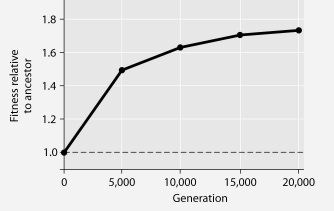Multiple Choice
The following questions refer to Figure 27.1.
In this eight-year experiment, 12 populations of E. coli, each begun from a single cell, were grown in low-glucose conditions for 20,000 generations. Each culture was introduced to fresh growth medium every 24 hours. Occasionally, samples were removed from the populations, and their fitness in low-glucose conditions was tested against that of members sampled from the ancestral (common ancestor) E. coli population.

Figure 27.1
-If new genetic variation in the experimental populations arose solely by spontaneous mutations, then the most effective process for subsequently increasing the prevalence of the beneficial mutations in the population over the course of generations is
A) transduction.
B) binary fission.
C) conjugation.
D) transformation.
E) meiosis.
Correct Answer:

Verified
Correct Answer:
Verified
Q18: The thermoacidophile, Sulfolobus acidocaldarius, lacks peptidoglycan, but
Q19: Which statement about the domain Archaea is
Q20: In a hypothetical situation, a bacterium lives
Q21: Which of the following is an important
Q22: Which of these statements about prokaryotes is
Q24: Though plants, fungi, and prokaryotes all have
Q25: Foods can be preserved in many ways
Q26: Which statement about bacterial cell walls is
Q27: Which of the following obtain energy by
Q28: Which question, arising from the results depicted